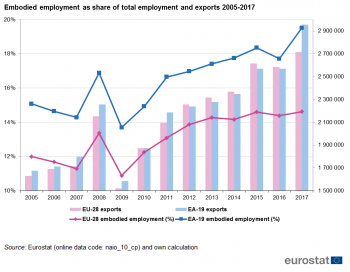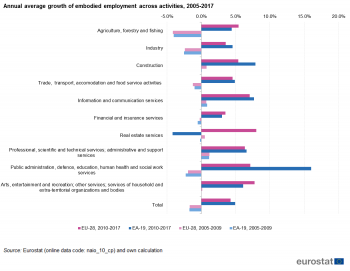Archive:Consolidated supply, use and input-output tables
In 2015 European exports accounted for 13 % of total EU employment, with 30,9 million people employed
- Data extracted in February 2017. Most recent data: Further Eurostat information, Main tables and Database. Planned update of the article: December 2018.
This article presents the latest available European consolidated supply, use and input-output tables for the period from 2005 to 2015 in terms of the NACE Rev. 2 classification.
The consolidated supply, use and input-output tables are used for macro-analysis of the European Union (EU) and euro area (EA) economies. They give an annual snapshot of overall production and use of products, distinguishing 64 NACE activities and 64 products from the CPA classification. Input-Output Tables are particularly used as a well-established tool for analytical purposes (economic analysis, social accounting matrices, and environmental accounts). The data are broken down into 10 activities and 10 product groups.






Main statistical findings
In 2015 European exports accounted for 13 % of total EU employment, with 30.9 million people employed
The total number of people employed by EU firms engaged in exporting activities (directly and indirectly) reached 30.9 million in 2015, 26 million of whom were in the EA. This represents 13 % of total EU employment in 2015 and 17 % of EA employment (see figures 1 and 2). The figure for employment embodied in exports refers to the number of people employed by firms that are directly engaged in exporting activities (direct effects), including those employed by upstream industries for supplying the necessary inputs to these firms (indirect effects). The production of exported manufactured products remains the major contributor to employment in the EU, encompassing 18.3 million people directly and indirectly. Next come wholesale trade, transport, accommodation and food service activities, accounting for 6.2 million employed people. The third major contributor are professional, scientific and technical activities, and administrative and support service activities, with 3.3 million people employed. The EA required fewer people for the production of its manufactured exports (around 15.7 million people) and the export of trade, transport, accommodation and food service activities (5.2 million people). The total number of people employed by firms engaged in exporting activities in the EU and the EA has grown by an annual average rate of 1.6 % over the last 10 years (from 2005 to 2015). However this development comprises two opposing effects: an annual average decline of 1.7 % from 2005 to 2009, immediately followed by an annual average growth of 3.9 % from 2009 to 2015 (Figure 3). Those two opposing effects can be seen in the activities reviewed, except for professional, scientific and technical services, administrative and support services and information and communication services where both sub-periods exhibit positive average annual growth.
In 2015 the EU economy was more oriented towards services and public administration than industry
Figure 4 shows that the EU economy is more geared to services than industry, construction or trade. All services account for 42 % of total output in the EU while industry accounts for 32 % of total output, construction for 6 % and trade for 17 %. Financial services and real-estate services together, professional, scientific and technical services and public administration services are of equal importance in terms of total output (about 11 %). The EA economy resembles the EU economy. For EA the industry represents a slightly bigger share of total output (35 %) than EU (32 %) while services in EA account for less (38 %) than in EU (42 %).
Intermediate consumption represents the most costly input in the EU economy
Intermediate consumption represents the most costly input in the EU economy (Figure 5) accounting for 51 % of total output in 2015 while labour input is the second largest cost, accounting for 25 % of output. The input-output (I-O) tables show the production structures of an economy. The columns in the tables represent the cost structure of the industry and the rows the composition of its revenues. The value added is the difference between output and intermediate consumption.
The I-O tables highlight differences across different activities in the EU. The main input for agriculture, industry and construction activities relates to intermediate consumption comprising 52 %, 58 % and 57 % of total output respectively. Conversely, real estate services are primarily based on the generation of gross value added, representing 69 % of total output in 2015. In administration and other public services activities, labour input accounts for the larger costs — 53 % of total output.
In the EU one additional unit of final demand would create 2.2 units of industrial output
Output multipliers reflect the direct and indirect requirements of domestic production per unit of final demand. One additional unit of final demand for agricultural products would generate around two units of revenue/output in the EA and in the EU (Figure 6). In the EU, the biggest output multiplier is for industrial products, where one additional unit of final demand would create 2.2 units of output (2.1 in the EA). Output multipliers are slightly higher in the EU than in the EA, i.e. the EU economy would produce more than the EA economy in response to an increase of one unit of final demand.
The supply and use of chemical products in the EU: 16 % of the production stems from imports and 23 % of the production is exported
Chemical products (CPA 20 of the products classification) are industrial products either produced by European companies or imported. Of the EUR 678 billion of chemical products (EUR 577 billion in the EA), 16 % are imported from outside the EU (19 % from outside EA). The European domestic production of chemicals represents 84 % of the chemical products supply (81 % of domestic EA production) from which 88 % are produced by the chemical industry itself in both the EU and EA, with the remaining 12 % being the secondary production of other industries. As regards use, 67 % of chemical products are used in the EU as an intermediate consumption item in the production of another product, e.g. transformed to pharmaceuticals (64 % in the EA) and 23 % as exports in the EU (29 % in the EA). Their use as a final consumption item accounts for only 9 % (7 % in the EA). Chemical products are not investment goods — their use in gross capital formation is nil in the EU and EA. For each product, the sum of the different uses equals the total supply. Both supply and use are recorded in monetary terms, at the current prices of the reference year and in basic prices.
An additional EUR 1 spent in the chemical industry would increase the output of the EU in 2015 by EUR 2.27
Looking at the 10 main sectors of activities, the sector of industry including the chemical industry generates the biggest output multiplier on the EU economy in 2015. For an additional EUR 1 spent in the manufacturing sector, the cumulative revenues would be increased by EUR 2.20 (Euro 2.12 in the EA). An additional EUR 1 spent on chemical products production would generate revenue of EUR 2.27. The output multiplier for an industry is expressed as the ratio of direct and indirect output changes to the direct output change due to a unit increase in final demand. If there is an increase in final demand for a particular product, we can assume that there will be an increase in the output of that product, as producers respond to meet the increased demand; this is the direct effect. As producers increase their output, there will also be an increase in demand on their suppliers and so on down the supply chain; this is the indirect effect. The result of the direct and indirect effects will be an increase in the level of household income throughout the economy due to increased employment. A proportion of this increased income will be re-spent on final goods and services — this is the induced effect. The construction sector follows the industry sector closely with an output multiplier of 2.16 (2.13 for the EA), while the real estate services sector has the smallest output multiplier — 1.46 (1.41 for the EA).
Data sources and availability
On the basis of the European I-O tables, a standard input-output technique was used to calculate the results of the Leontief quantity model applied to employment. First, a domestic input coefficient matrix (A) was calculated for each homogeneous branch of activity, showing direct input requirements for the production of one unit of output. Then the Leontief inverse matrix (the inverse of I — A, being I, the identity matrix) was computed to obtain the matrix of output multipliers. Next, the inverse matrix was post-multiplied by a column vector of exports to calculate the total output embodied in those exports. Finally, output coefficients of employment pre-multiplied the former results to obtain the figure for employment embodied in exports.
The figure for employment embodied in exports is measured by hours worked of people employed by firms directly engaged in export activities (direct effects), including those employed by upstream industries for the supply of the necessary inputs (indirect effects).
Eurostat compiles supply and use tables for the EU, the euro area and the US ( BEA) under the ESA 2010 methodology. All statistics relating to national accounts are now developed in this methodological framework, which is the European adaptation of the 2008 System of National Accounts. For the US, the make and use tables at producers’ values are available from the Bureau of Economic Analysis (BEA).
Context
The data are collected under the European System of National and Regional Accounts (ESA 2010) transmission programme. EU Member States transmit supply and use tables (SUTs) to Eurostat annually and input-output tables (IOTs) every five years, up to 36 months after the end of the reference period.
The SUTs give detailed information on production processes, interdependencies in production, the use of goods and services, and income generated in production. They form the basis for symmetrical IOTs, which are produced by applying certain assumptions to the relationship between outputs and inputs and are used by policy-makers for input-output analysis.
European tables for the years 2010 to 2013 are based on a consolidation of available national supply and use tables. The data for only a few Member States is missing and has been estimated for the purpose of the European tables. Only a few countries’ data is available for 2014 (the deadline for transmission is the end of 2017). The non-available tables have been estimated based on data from previous years. The European tables for 2015 are the result of projection methods based on the 2014 European consolidated tables and macroeconomic data for 2015. Environmentally extended IOTs, an extension in Eurostat, represent another powerful analytical instrument to inform policy.
Eurostat has compiled consolidated European tables for the EU-28 and the EA in ESA 2010 from reference year 2010 onwards.
See also
- Building the System of National Accounts - supply and use tables (chapter of online publication Building the System of National Accounts)
- National accounts and GDP
- Supply and use tables - input-output analysis (background article)
Further Eurostat information
Publications
- European exports 2000-2007: direct and indirect effects on employment and labour income in the EU 27 and euro area - Statistics in focus 36/2012
- CO2 emissions induced by EU's final use of products are estimated to be 9 tonnes per capita - Statistics in focus 22/2011
Database
- Supply, use and Input-output tables (naio_10_cp)
Dedicated section
Methodology / Metadata
- Eurostat Manual of Supply, Use and Input-Output Tables
- Methodological information on the compilation of the US supply and use tables in European classications, September 2013
- Methodological information on the consolidated European tables for years 2008 and 2009
- Technical Documentation eeSUIOT project
External links